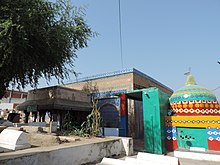Jahaniyan Jahangasht
This article has multiple issues. Please help or discuss these issues on the talk page. (Learn how and when to remove these template messages)
|
Makhdum Jahaniyan Jahangasht | |
|---|---|
 | |
| Personal | |
| Born | Mir Sayyid Jalaluddin 19 January 1308 |
| Died | 3 February 1384 (aged 76) |
| Religion | Islam |
| Relatives | Jalaluddin Surkh-Posh (grandfather) Shah Jewna (nephew) |
Mīr Sayyid Jalāl ad-Dīn an-Naqwī al-Bukhārī (Persian: میر سید جلال الدین النقوی البخاری; 1308-1384), better known as Jahāniyān Jahāngasht (Persian: مخدوم جہانیاں جہان گشت), was a Sufi saint from South Asia.
Biography[]


Mir Sayyid Jalaluddin Bukhari was born into a Muslim family on 19 January 1308 AD (14 Shaban 707 AH). His father, Syed Ahmed Kabir, was the youngest son of Jalaluddin Surkh-Posh of Bukhara.[1]
He was later given the title of Jahaniyan Jahangasht from which he gained prominence. He travelled to many countries, and visited Mecca 36 times in his life. He married the daughter of his half-uncle Sadruddin Muhammad Ghawth.[2] He travelled with Lalleshwari, one of his grandfather's female disciples, to Kashmir.[3]
He visited Hazrat Pandua, the first capital of the Bengal Sultanate, where he led the janazah of Alaul Haq Pandwi, the court scholar of Bengal. Some of his gifts to Bengal include a Jhanda which is preserved in the dargah of Jalaluddin Tabrizi in Pandua and a Qadam Rasul at the in Gaur. The nearby of the 16th-century is said to be named in his honour too.[4] Every year, during the urs of Akhi Siraj Bengali, Jahangasht's jhanda is taken from Tabrizi's dargah to Akhi Siraj's mausoleum.[5]
Legacy[]

His descendants use the surname Naqvi Bukhari, and belong to the Suhrawardi Saadat. Many of them migrated to Tando Jahania in Sindh.[6][7][8][9]
See also[]
References[]
- ^ Marat-e-Jalali (مرآت جلالی) by Syed Khalil Ahmed Bukhari Hassami, First Edition 1918, Allahabad, Second Edition 1999, Karachi.
- ^ Hassami S. K. A. B. Marat-e-Jalali (Red Clothed man from Bukhara) First Edition 1918, Allahabad, Second Edition 1999, Karachi.
- ^ Sikand y. "The Muslim Rishis of Kashmir: crusaders for love and justice.", Accessed 23 June 2017
- ^ Abdul Karim (2012). "Shaikh Akhi Sirajuddin Usman (R)". In Islam, Sirajul; Miah, Sajahan; Khanam, Mahfuza; Ahmed, Sabbir (eds.). Banglapedia: the National Encyclopedia of Bangladesh (Online ed.). Dhaka, Bangladesh: Banglapedia Trust, Asiatic Society of Bangladesh. ISBN 984-32-0576-6. OCLC 52727562. Retrieved 31 January 2022.
- ^ "Archived copy". Archived from the original on November 9, 2013. Retrieved October 19, 2020.
{{cite web}}: CS1 maint: archived copy as title (link) - ^ "Archived copy". Archived from the original on 2016-05-18. Retrieved 2014-07-25.
{{cite web}}: CS1 maint: archived copy as title (link) - ^ "Sufis & Shaykhs - World of Tasawwuf". Spiritualfoundation.net. Retrieved 2013-07-15.
- ^ UNESCO World Heritage Centre. "Tomb of Bibi Jawindi, Baha'al-Halim and Ustead and the Tomb and Mosque of Jalaluddin Bukhari - UNESCO World Heritage Centre". Whc.unesco.org. Retrieved 2013-07-15.
- Punjabi Sufi saints
- 1308 births
- 1384 deaths
- Hashemite people
- Shrines in Pakistan